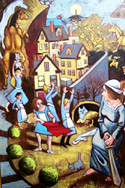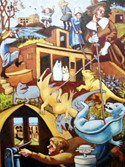Clov
In her seventh-grade music class at Barrington Middle School, Hilary was required to write reviews of pop recordings. The teacher, a bass player in a local cover band, brought in back issues of Rolling Stone to give the kids an idea of what to say; a review of Graffiti Bridge was presented as a paradigm case. The assignment was to review one song from Tears for Fears' Seeds of Love album. To increase the students' pop music-critical vocabulary, the teacher emphasized the concept of the pre-chorus during in-class listening sessions. On the exam, students had to evaluate the bass playing on "Lucy in the Sky with Diamonds." Hilary gave it a seven but was unable to explain, since she couldn't tell which instrument was the bass.
I find myself now in a similarly awkward position. I guess I'll start with some sounds, and if you listen to them you can just skip the review:
I like this music because I think it's good, but I know about it because Chris is a friend. During the first few days of college, when the altered circumstances of my life were doing violence to my sense of self and showing it to be neither natural nor necessary, I met Chris at a music department meeting. I was there to drop my music courses and change my intended major; Chris was there to do just the reverse, and it became his lot, not mine, to study composition, theory, and jazz guitar at college.
The extent to which this academic influence mars Clov's music is a subject over which reasonable people can, and do, disagree. (This criticism concerns Chris's songs more than Ben's.) City Song, a vaguely Latin thing in seven, could have been a Kurt Rosenwinkel tune; the guitar solo on This is Fun for Me—which I thought I had learned note-for-note before Chris pointed out a couple flubs—is strongly influenced by Pat Metheny; the first six chords to The Sun Bear Six are borrowed from a part of Keith Jarrett's Sun Bear Concerts; Two Saxophone Players, a song about a young jazz student who aspires to crush a complacent and beer-bloated upperclassman, is built over a D minor-to-Eb minor form familiar from "So What" and "Impressions," and a lyric about "Coltranish subs" is delivered over a programmatic snippet of "Giant Steps" changes. A bit of a fusion nut myself, I can't feel the force of criticisms that Clov sounds too brainy or jazzy. Whether weird chords and melodies can decode as candy-pop may be up to the openness of individual ears; I guess I think that these songs come off as pretty darn musical.
Interestingly, an equally typical complaint is that Clov’s music is too emotive. The simple melodies of You're Invited are too guileless to be sincere in some trickily cool way, and they overlap too innocently to sound contrapuntal—they just share space politely; the B-section, whose emotional effect is hastened by a near quantum-level shift in the acoustic presence of the vocals, might make you cry. Ben holds nothing back on Denbow; his urgent vocal performance transforms the song's theme—that a name has an expressive life independent of what it names—from a precious observation about words to a consuming obsession with occult forces. The melody of It's Softer Now would sound false coming from any singer who didn't believe that music is art. This suggests a second factor influencing how a listener will handle Clov; perhaps you have to believe, along with Ben and Chris, that music is, starting from its bare formal features, a spiritual force; that music should be transformative and important; and that trust is its only possible foundation.
I find myself now in a similarly awkward position. I guess I'll start with some sounds, and if you listen to them you can just skip the review:
The SensualistThese are songs by Clov, the loved-or-hated non-performing duo of Chris Weisman and Ben Stamper. Chris and Ben have been making home recordings of their music since they were high-schoolers in the early 90s, and they've recently formatted the adult form of their project—a run of six short albums, one a year since 2000—as MP3s. This is their homepage; here is a shortcut to their recent albums.
A Field Strewn with Thorns/This is the Story
Two Top Teeth
I like this music because I think it's good, but I know about it because Chris is a friend. During the first few days of college, when the altered circumstances of my life were doing violence to my sense of self and showing it to be neither natural nor necessary, I met Chris at a music department meeting. I was there to drop my music courses and change my intended major; Chris was there to do just the reverse, and it became his lot, not mine, to study composition, theory, and jazz guitar at college.
The extent to which this academic influence mars Clov's music is a subject over which reasonable people can, and do, disagree. (This criticism concerns Chris's songs more than Ben's.) City Song, a vaguely Latin thing in seven, could have been a Kurt Rosenwinkel tune; the guitar solo on This is Fun for Me—which I thought I had learned note-for-note before Chris pointed out a couple flubs—is strongly influenced by Pat Metheny; the first six chords to The Sun Bear Six are borrowed from a part of Keith Jarrett's Sun Bear Concerts; Two Saxophone Players, a song about a young jazz student who aspires to crush a complacent and beer-bloated upperclassman, is built over a D minor-to-Eb minor form familiar from "So What" and "Impressions," and a lyric about "Coltranish subs" is delivered over a programmatic snippet of "Giant Steps" changes. A bit of a fusion nut myself, I can't feel the force of criticisms that Clov sounds too brainy or jazzy. Whether weird chords and melodies can decode as candy-pop may be up to the openness of individual ears; I guess I think that these songs come off as pretty darn musical.
Interestingly, an equally typical complaint is that Clov’s music is too emotive. The simple melodies of You're Invited are too guileless to be sincere in some trickily cool way, and they overlap too innocently to sound contrapuntal—they just share space politely; the B-section, whose emotional effect is hastened by a near quantum-level shift in the acoustic presence of the vocals, might make you cry. Ben holds nothing back on Denbow; his urgent vocal performance transforms the song's theme—that a name has an expressive life independent of what it names—from a precious observation about words to a consuming obsession with occult forces. The melody of It's Softer Now would sound false coming from any singer who didn't believe that music is art. This suggests a second factor influencing how a listener will handle Clov; perhaps you have to believe, along with Ben and Chris, that music is, starting from its bare formal features, a spiritual force; that music should be transformative and important; and that trust is its only possible foundation.




